Marine litter issues, impacts and actions
A study that will contribute to developing a marine litter strategy for Scotland’s seas in light of the Marine (Scotland) Act 2010.
4 Current Status and Remediation Initiatives
Baseline data for Scotland are limited mostly to coastal surveys of beached marine litter. For Scotland the key datasets available are via the Marine Conservation Society ( MCS) Beachwatch programme, Keep Scotland Beautiful and KIMO's Fishing for Litter.
4.1 Coastal litter
In 2010, a total of 53,162 items of litter were collected on selected Scottish beaches, covering a length of 22.3 km. The Scottish average of 2382 items per km was higher than the UK average (1969 items/km) of the same year (Figure 4-1). Since 1996, there has been an overall decrease in litter density (Figure 4-2), but there has been a steady rise since 2000 ( MCS, 2009).
An analysis of the type and sources of litter from MCS (2011) revealed 37.5% of all Scottish litter originated from the 'public', 29.6% non-sourced, 20.5% from SRD, 8.9% from fishing, 1.7% from shipping, 1.6% fly-tipped and 0.2% medical. This does identify those sources requiring most attention but it should be noted that litter items can be very difficult to source either due to the impact of weathering or their generic nature.
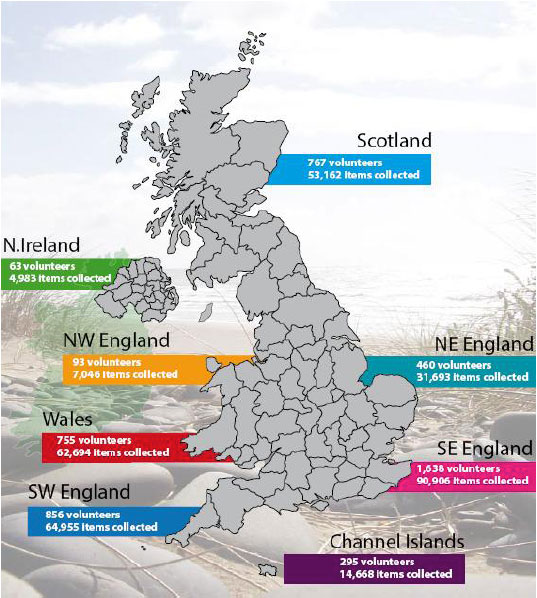
Figure 4 ‑ 1 Average number of litter items per km in 2008 ( MCS, 2011)
Sewage related debris ( SRD) accounted for 20.5% of coastal litter (487.8 items/km)during the 2010 survey; significantly higher than the 7.3% UK average. East Bay Helensburgh beach was disproportionably affected by SRD, and has skewed the Scottish average. By removing the results from this beach, SRD constitutes 12% of all litter found on Scottish beaches, still nearly double the UK average.
To work towards resolving this issue Scottish Water have recently completed an extensive network upgrade in Helensburgh, which aims to reduce the frequency of CSO use and consequently the levels of SRD. This work was completed prior to the 2010 survey.
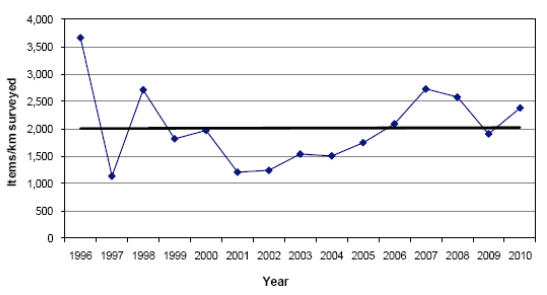
Figure 4 ‑ 2 Mean items/km in Scotland, Beachwatch surveys 1996-2010 (Taken from MCS, 2011)
At the UK level plastic continued to be the most dominant type of marine litter, accounting for 63.5% of all litter which is proportionally the highest to date. The most common items representing 41% of all the plastic recorded, were plastic pieces <2.5 cm, plastic pieces > 2.5 cm, wrappers (crisp, sweet, lolly, sandwich), rope (including cord & string) and lids. In addition, many items in the sewage related debris category are comprised of plastic parts; therefore the overall percentage of plastics could be over 75%.
Other litter types include polystyrene (9%), paper (3.7%), metal (6%), glass (3.7%), sanitary products (7.3%), animal faeces (0.4%), and medical (0.3%) of which may pose potential biohazard risks ( MCS, 2011).
4.2 Regional Seas
The Defra report, Charting Progress (Defra, 2005a) recently updated as Charting Progress 2 (Defra, 2011a) assessed Beachwatch data to provide an indicator on one of a number of key human impacts on the marine environment. For the purpose of Charting Progress, UK waters are separated into eight regional seas (Figure 4-3).
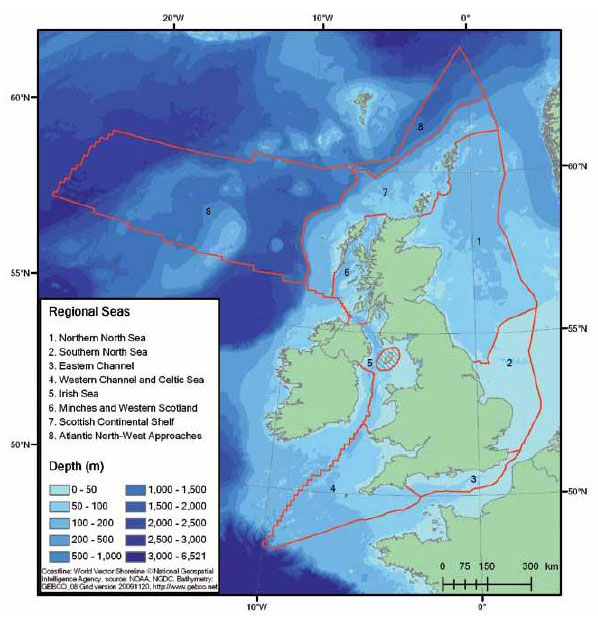
Figure 4 ‑ 3 Charting Progress 2 Regional Sea boundaries (Defra, 2011a)
Two regions are particularly relevant to Scotland; Region 6 and 7. Region 8 although relevant did not have sufficient data.
Region 1 (Northern North Sea) includes the east coast of Scotland, but extends past the Scottish border to include the English coastline and Region 5 (Irish Sea) includes the west coast of Scotland, and also includes the coastlines of Wales and Ireland. Thus regional summaries for these coastlines will be unrepresentative of Scotland only. Both regions however have been summarised as having an aesthetic and economic problem as a result of beach litter, and that more research is required to assess the overall ecological impact (Defra, 2011b).
In 2009, only three beaches (totalling 2.7 km) were surveyed in region 6, therefore conclusions drawn for this data could be unrepresentative of the region.
Public debris was found to be the main source of litter, contributing 53.5% of litter; proportionally higher than the other regions (figure4-4) ( MCS, 2009). Comparatively region 6 also had the second highest proportion of shipping related litter (3.3%). Only four items (0.2%) of medical waste were recorded and four items were fly-tipped (0.2%) possibly reflecting the small population sizes in the region. Additional uncertainties for this region include the large proportion of litter that could not be sourced (24.5%) ( MCS, 2009).
In 2009, two beaches (totalling 0.1 km) were surveyed in region 7, and the high litter density is a result of this small sample size ( MCS, 2009). Conclusions drawn from this data could be unrepresentative of the region. Fishing debris was found to be the main source of litter, contributing 34.8% of litter; proportionally higher than the other regions. Comparatively region 7 also had the highest proportion of shipping related litter (6.6%) and the lowest proportion of SRD (0.7%). No medical waste was recorded and only 2 items were fly-tipped (0.2%) ( MCS, 2009).
These results may reflect the substantial influence fisheries and shipping have in this region, and the comparatively low population densities (and consequently the low levels of SRD, public sourced litter and fly tipping). Additional uncertainties for this region include the large proportion of litter that could not be sourced (33.5%).
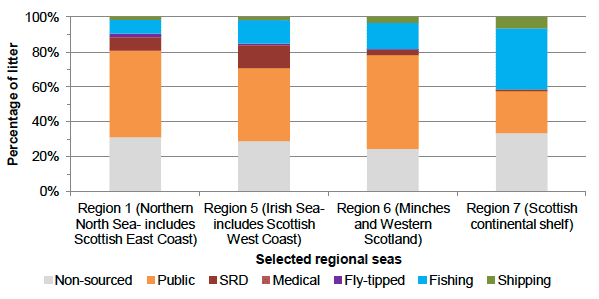
Figure 4 ‑ 4 Sources of litter in selected regional seas, relating to Scotland (adapted MCS, 2009)
4.3 Benthic and suspended litter
Limited baseline data exits for benthic and suspended litter; KIMO's (Kommunenes Internasjonale Miljøorganisasjon) Fishing for Litter project provides the majority of this information.
KIMO provides fishing boats with bags to collect marine sourced litter.When full, these bags are deposited on the quayside for collection and subsequent disposal. The first phase of the project ran from 2005-2008 and the second phase will run from 2008-2011( KIMO, 2008). As of the second project phase, 162 vessels and 17 harbours are actively participating in the scheme.
From data on total tonnage landed in harbours by various fishers, there is a slight increase in total tonnage (size not weight) of litter collected from 2005-2008. This is most likely attributed to the greater uptake by fishers and increased frequency of surveying rather than increases in the abundance of litter. There are also no significant differences between tonnage (averages) on the east and west coasts. However in the 2007-2008 season Ullapool landed 8.56 tonnage of marine litter, much greater than other harbours in the same period (Figure 4-5).
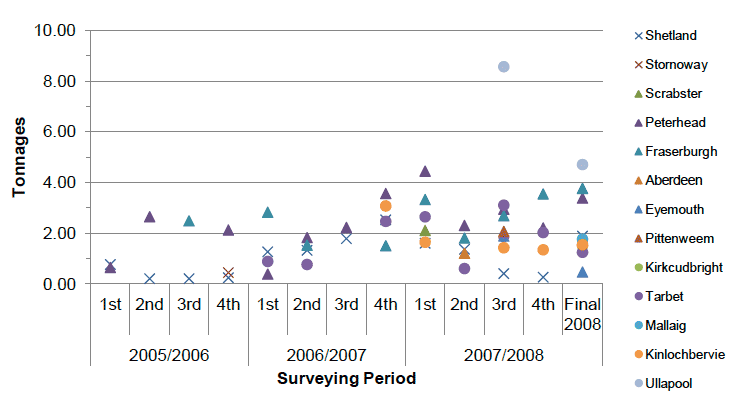
Figure 4 ‑ 5 Tonnage of marine litter landed at Scottish harbours during the period 2005-2008, (adapted from KIMO, 2008)
The overall conclusions of the fishing for litter scheme correspond with Beachwatch data and the EcoQO studies of plastics and fulmars; plastics and polystyrene are the predominant types of marine litter found in and around the coastal waters of Scotland ( KIMO, 2008; MCS, 2009; OSPAR, 2010).
Indeed these two types of litter contributed to 74% of the total litter landed at six harbours during the surveying period ( KIMO, 2008). Specific types of litter such as plastic bottles, buoys and gloves were considerably more common than other types in some harbours; however the causes behind these occurrences are unknown.
4.4 Summary of major surveys and initiatives
4.4.1 UK
MCS Adopt-a-Beach and MCS Beachwatch are initiatives organised by the Marine Conservation Society, whereby local individuals, groups and communities clean their coastal environment. The MCS Beachwatch project is in its 18th year with thousands of volunteers taking part every year. The annual MCS Beachwatch Big Weekend event takes place on the 3rd weekend of September every year and the data collected are used for the annual MCS Beachwatch report and contributes to the International Coastal Cleanup data.Adopt-a-Beach involves groups monitoring 4 times a year. The data collected by volunteers are used to provide an insight in to marine litter on UK and regional level beaches.
The Bag It & Bin It initiative is co-ordinated by Water UK on behalf of all water companies and authorities in the UK. It aims to improve SRD issues by public campaigns and publicity materials. Regional campaigns have also been initiated to monitor the effectiveness of this approach (Fanshawe & Everard, 2002).
The Marine Litter Research Programme, organised by the Tidy Britain Group was launched in 1973. The primary aim of which, is to generate statistics on the major sources of marine litter, using standardised methodologies and analytical techniques over varying spatial and temporal scales. Major trends in source, type, quantify and rates of accumulation of plastics in UK coastal and oceanic waters were calculated.
Surfers Against Sewage is a not-for profit environmental pressure group focused on the protection of the UK's oceans, waves and beaches, via campaigning, volunteering, conservation, education and scientific research. The group was formed by surfers to help tackle the issue of sewage discharges across the UK.
Various beach award schemes operate across the UK; Blue Flag in all nations, Quality Coast Award in England, Green Coast Award in Wales and Northern Ireland and the Seaside Award in Scotland, Wales and Northern Ireland. All awards represent a high standard for the coastal environment and beach amenities, which beach managers and local authorities work towards. They have been instrumental in raising public awareness on environmental issues such as litter, dog refuse and bathing water quality. Blue Flag Award beaches are aimed at resort beaches, which must meet "guideline" EC Bathing Waters Directive standards and also have adequate facilities for litter and dog refuse as well as basic amenities (public toilets, telephones, parking, and disabled facilities).Seaside Award beaches need to meet the "mandatory" EC Bathing Waters Directive standard only. The Green Coast Award is aimed at rural beaches achieving Guideline water quality. All other awards need to meet at least the Mandatory EC Bathing Waters Directive standard.
The Marine Pollution Control Unit ( MCPU) organised by the Maritime and Coastguard Agency assists the co-ordinating of shoreline clean up after large pollution events. MPCU also follows up on reports on illegal dumping of garbage at sea, with the view of initiating prosecutions under the Merchant Shipping (prevention of Oil Pollution) Regulations 1996 and the Merchant Shipping (prevention of Pollution by Garbage) Regulations 1998.
Seasearch organised by MCS, catalogues coastal habitats and anthropogenic impacts including litter in the UK. The MCS and PADI published a guide to underwater clean ups in 1999, encouraging recreational divers to survey and remove sub-tidal litter, however data from these has proved insufficient for further analysis here.
The Green Blue interacts with the boating public on the topic of litter. In their work with DEFRA it was the topic of greatest concern, with 75% being 'very concerned' about it. In addition, their findings showed it was the topic that most people reported taking action with 62% saying they did something to reduce litter and waste 'all the time' since their interaction with The Green Blue.
4.4.2 Scotland
Scotland's Zero Waste Plan sets out the Scottish Government's vision for a zero waste society. This vision describes a Scotland where all waste is seen as a resource; waste is minimised; valuable resources are not disposed of in landfills, and most waste is sorted, leaving only limited amounts to be treated. To achieve this vision the Plan sets out a raft of new measures. Achieving zero waste will also contribute to Scotland's climate change and renewable energy targets.
Keep Scotland Beautiful is an independent charity which undertakes assessments and monitoring of beaches applying for the Blue Flag and Seaside Awards in Scotland. KSB also runs the National Spring Clean campaign (March-May every year); a coordinated campaign for voluntary clean ups and litter picks. Areas covered include coastal paths and beaches as well as terrestrial sites. During April 2010 152 beach litter picks (out of a total of 1406) were registered as part of National Spring Clean, involving 9,797 volunteers. No monitoring takes place by volunteers, although they are encouraged to record the brands of litter found. These clean ups, along with the MCS Beachwatch and Adopt-A-Beach clean ups are not captured anywhere financially, but the volunteer hours and rates would be substantial.
The Think Before You Flush campaign finished in 2002 and was replaced with a branded Bag it and Bin it - don't flush it campaign in 2003. This was funded by Scottish Government, Clean Coast Scotland and Scottish Water.
The GRAB TRUST-Beaches and Marine Litter
Beaches and Marine Litter Project ran by the GRAB Trust, aims to raise awareness of the impacts of marine litter and to work with schools and community groups to try and tackle the problem.
As well as organising beach clean events, the Trust provide advice and support to community groups wishing to run their own clean ups, often as a way of fundraising for the group, via money paid by the Trust dependent on the length of beach cleaned and whether there were any black spots.
A range of marine litter education workshops and activities in local schools (Primary and Secondary) and with youth groups are undertaken. The education activities are varied and are suitable for pre-five groups through to 16 year olds. They can explore a range of issues including impact, harm, responsible behaviour, identifying and quantifying litter, looking at how long litter items last in the environment as well as quizzes and art activities. The activities are planned to encourage children to be active in their learning and to have fun exploring issues whilst being in line with the Curriculum for Excellence.
The GRAB Trust attend and organise events throughout the year to raise awareness of the impacts of beach and marine litter through visual displays and printed information and to speak to people face to face to encourage them to get involved in beach cleaning and in Reducing, Reusing and Recycling.
By running the Argyll and Bute Beach Forum people are brought together who have a shared passion and commitment to trying to tackle the beach and marine litter problem and is a way of keeping interested groups and individuals in touch with issues and events in the area, via regular bulletins and newsletters.
Forth Estuary Forum's Coastal Litter Campaign
The Forth Estuary Forum's Coastal Litter Campaign encouraged communities and organisations to initiate and carry out co-ordinated clean-up events in association with the Marine Conservation Society's Adopt a Beach campaign. Varying methods were employed to raise awareness of the types, sources and impacts of marine litter using existing initiatives including the Bag It and Bin It campaign, Blue Flag, and the MCS Adopt-a-Beach campaign. An important aspect of the Coastal Litter Campaign was the ability to monitor and evaluate the changing trends for marine litter in the Forth and allow for the development of individual programmes of action to tackle the litter at source. A team of dedicated volunteers used a scientifically standardised technique to assess trends in the deposition of fresh marine litter each month. The campaign found that the majority of the litter came form land based sources and therefore was the focus of their campaigns.
The high level of interest in the Coastal Litter Campaign and the subsequent positive comments they received, help to demonstrate the potential success and impact of such
4.4.3 initiatives. England and Wales
In England and Wales, including representation from Scotland, the National Aquatic Litter Group ( NALG), a consortium of partners including the EA, SEPA and EHS ( NI) conducted an assessment of the aesthetic state of bathing water beaches, using a standardised monitoring and assessment protocol (Defra, 2005b). Over the period 2000-2002 all designated bathing waters in England and Wales were surveyed annually and beaches were classified from A (very good) to D (poor). Parameters including SRD, general litter, oil dog excrement, harmful debris and large accumulations of litter were recorded (Defra, 2005b). In 2010 the group was disbanded due to funding issues, though much of the work is still available from the EA.
In 2000, 77% of coastal bathing waters beaches were graded A or B (very good or good) in beach aesthetic surveys and in 2002 this rose to 82%. During the same period the number of grade D beaches fell from 10% to 5%. The long-term improvement in the aesthetic state of these beaches cannot be assessed from these results however, due to the short-term nature of the monitoring (Defra, 2005b).
The General Quality Assessment ( GQA) scheme, organised by the Environment Agency (originally National Rivers Authority) aims to provide an objective classification scheme against which to measure water quality (Fanshawe & Everard, 2002). Within the marine environment these include sanitary chemistry (Dissolved Oxygen and Ammonia), Nutrients, Biological Quality, Heavy Metals in Sediments and Aesthetic Quality (with a litter component).
4.4.4 Northern Ireland
Northern Ireland holds a dataset on coastal litter by the Northern Ireland Environment Agency ( NIEA). The NIEA has carried out surveys since 1999, on identified beaches throughout the bathing season (1 st Jun- 15 th Sep) ( NIEA, 2011). The surveys use a rapid scan technique, which counts and categorises the litter whilst being collected (ibid). So far the quantities of litter collected have been stable, at 8,198 items annually; 42% was packaging and 39% was plastic ( NIEA, 2011).
As well as the coastal surveys, the NIEA and Agri-Food Biosciences Institute ( AFBI) completed a litter survey of the seafloor of the Irish Sea ( NIEA, 2011). The surveys were conducted by fisheries trawlers and found 60% of all litter was plastic.
The Northern Ireland Estuarine and Coastal Waters Classification, adopted from the ADRIS classification scheme and organised by the Environment & Heritage Service ( EHS NI) measures the quality of estuaries and coastal waters including an aesthetics component (Fanshawe & Everard, 2002).
The Lough Foyle Research Vessel: Irish Sea Study Trawls undertaken by DANI Agricultural and Environmental Sciences Division, carried out population assessment of demersal, benthic fish and shellfish stocks (Fanshawe & Everard, 2002). As part of a sub-sampling process marine litter was identified in catches, of which high levels of all types were recorded.
4.4.5 International
There are various international campaigns such as Arc Manche (France), Coastwatch Europe, International Coastal Clean Up Initiative ( US), Marine Litter Monitoring Project ( OSPAR), SPCC Beach Pollution Index (Australia) and research by KIMO.
The potential for Scotland to implement similar monitoring schemes is promising, due to the transferability of these methodologies and assessments to local coastal and marine waters. Linking to these existing initiatives would however, allow for Scotland to better coordinate with the global movement and allow for the use of developed resources and uniformed methodologies.
Contact
There is a problem
Thanks for your feedback